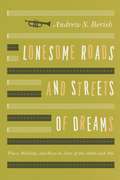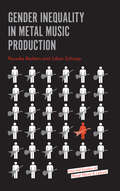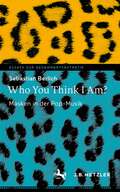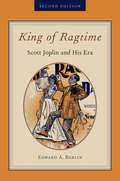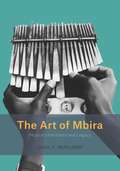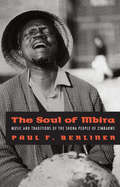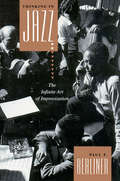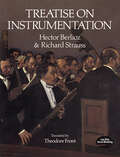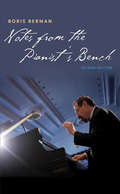- Table View
- List View
Lonesome Roads and Streets of Dreams: Place, Mobility, and Race in Jazz of the 1930s and '40s
by Andrew S. BerishAny listener knows the power of music to define a place, but few can describe the how or why of this phenomenon. In Lonesome Roads and Streets of Dreams: Place, Mobility, and Race in Jazz of the 1930s and ’40s, Andrew Berish attempts to right this wrong, showcasing how American jazz defined a culture particularly preoccupied with place. By analyzing both the performances and cultural context of leading jazz figures, including the many famous venues where they played, Berish bridges two dominant scholarly approaches to the genre, offering not only a new reading of swing era jazz but an entirely new framework for musical analysis in general, one that examines how the geographical realities of daily life can be transformed into musical sound. Focusing on white bandleader Jan Garber, black bandleader Duke Ellington, white saxophonist Charlie Barnet, and black guitarist Charlie Christian, as well as traveling from Catalina Island to Manhattan to Oklahoma City, Lonesome Roads and Streets of Dreams depicts not only a geography of race but how this geography was disrupted, how these musicians crossed physical and racial boundaries—from black to white, South to North, and rural to urban—and how they found expression for these movements in the insistent music they were creating.
Lonesome Roads and Streets of Dreams: Place, Mobility, and Race in Jazz of the 1930s and '40s
by Andrew S. BerishAny listener knows the power of music to define a place, but few can describe the how or why of this phenomenon. In Lonesome Roads and Streets of Dreams: Place, Mobility, and Race in Jazz of the 1930s and ’40s, Andrew Berish attempts to right this wrong, showcasing how American jazz defined a culture particularly preoccupied with place. By analyzing both the performances and cultural context of leading jazz figures, including the many famous venues where they played, Berish bridges two dominant scholarly approaches to the genre, offering not only a new reading of swing era jazz but an entirely new framework for musical analysis in general, one that examines how the geographical realities of daily life can be transformed into musical sound. Focusing on white bandleader Jan Garber, black bandleader Duke Ellington, white saxophonist Charlie Barnet, and black guitarist Charlie Christian, as well as traveling from Catalina Island to Manhattan to Oklahoma City, Lonesome Roads and Streets of Dreams depicts not only a geography of race but how this geography was disrupted, how these musicians crossed physical and racial boundaries—from black to white, South to North, and rural to urban—and how they found expression for these movements in the insistent music they were creating.
Lonesome Roads and Streets of Dreams: Place, Mobility, and Race in Jazz of the 1930s and '40s
by Andrew S. BerishAny listener knows the power of music to define a place, but few can describe the how or why of this phenomenon. In Lonesome Roads and Streets of Dreams: Place, Mobility, and Race in Jazz of the 1930s and ’40s, Andrew Berish attempts to right this wrong, showcasing how American jazz defined a culture particularly preoccupied with place. By analyzing both the performances and cultural context of leading jazz figures, including the many famous venues where they played, Berish bridges two dominant scholarly approaches to the genre, offering not only a new reading of swing era jazz but an entirely new framework for musical analysis in general, one that examines how the geographical realities of daily life can be transformed into musical sound. Focusing on white bandleader Jan Garber, black bandleader Duke Ellington, white saxophonist Charlie Barnet, and black guitarist Charlie Christian, as well as traveling from Catalina Island to Manhattan to Oklahoma City, Lonesome Roads and Streets of Dreams depicts not only a geography of race but how this geography was disrupted, how these musicians crossed physical and racial boundaries—from black to white, South to North, and rural to urban—and how they found expression for these movements in the insistent music they were creating.
Lonesome Roads and Streets of Dreams: Place, Mobility, and Race in Jazz of the 1930s and '40s
by Andrew S. BerishAny listener knows the power of music to define a place, but few can describe the how or why of this phenomenon. In Lonesome Roads and Streets of Dreams: Place, Mobility, and Race in Jazz of the 1930s and ’40s, Andrew Berish attempts to right this wrong, showcasing how American jazz defined a culture particularly preoccupied with place. By analyzing both the performances and cultural context of leading jazz figures, including the many famous venues where they played, Berish bridges two dominant scholarly approaches to the genre, offering not only a new reading of swing era jazz but an entirely new framework for musical analysis in general, one that examines how the geographical realities of daily life can be transformed into musical sound. Focusing on white bandleader Jan Garber, black bandleader Duke Ellington, white saxophonist Charlie Barnet, and black guitarist Charlie Christian, as well as traveling from Catalina Island to Manhattan to Oklahoma City, Lonesome Roads and Streets of Dreams depicts not only a geography of race but how this geography was disrupted, how these musicians crossed physical and racial boundaries—from black to white, South to North, and rural to urban—and how they found expression for these movements in the insistent music they were creating.
Lonesome Roads and Streets of Dreams: Place, Mobility, and Race in Jazz of the 1930s and '40s
by Andrew S. BerishAny listener knows the power of music to define a place, but few can describe the how or why of this phenomenon. In Lonesome Roads and Streets of Dreams: Place, Mobility, and Race in Jazz of the 1930s and ’40s, Andrew Berish attempts to right this wrong, showcasing how American jazz defined a culture particularly preoccupied with place. By analyzing both the performances and cultural context of leading jazz figures, including the many famous venues where they played, Berish bridges two dominant scholarly approaches to the genre, offering not only a new reading of swing era jazz but an entirely new framework for musical analysis in general, one that examines how the geographical realities of daily life can be transformed into musical sound. Focusing on white bandleader Jan Garber, black bandleader Duke Ellington, white saxophonist Charlie Barnet, and black guitarist Charlie Christian, as well as traveling from Catalina Island to Manhattan to Oklahoma City, Lonesome Roads and Streets of Dreams depicts not only a geography of race but how this geography was disrupted, how these musicians crossed physical and racial boundaries—from black to white, South to North, and rural to urban—and how they found expression for these movements in the insistent music they were creating.
Gender Inequality in Metal Music Production (Emerald Studies in Metal Music and Culture)
by Pauwke Berkers Julian SchaapFor over four decades, scholars have been investigating male dominance - both symbolically and numerically -within popular music. The heavier genres of popular music, metal music in particular, have been male dominated spaces, which are difficult to navigate for women participating as fans, musicians, or both. Studies on gender inequality in metal music have convincingly demonstrated how gender dynamics shape the reception of metal music and metal scenes all over the globe. Yet, they shed relatively little light on the extent of and reasons for metal music's male domination from a production perspective. This book fills this gap, offering is a systematic and large-scale overview of gender inequality in metal music production. In other words: how many women - compared to men - are participating in metal bands and what are the causes for the differences in participation?
Gender Inequality in Metal Music Production (Emerald Studies in Metal Music and Culture)
by Pauwke Berkers Julian SchaapFor over four decades, scholars have been investigating male dominance - both symbolically and numerically -within popular music. The heavier genres of popular music, metal music in particular, have been male dominated spaces, which are difficult to navigate for women participating as fans, musicians, or both. Studies on gender inequality in metal music have convincingly demonstrated how gender dynamics shape the reception of metal music and metal scenes all over the globe. Yet, they shed relatively little light on the extent of and reasons for metal music's male domination from a production perspective. This book fills this gap, offering is a systematic and large-scale overview of gender inequality in metal music production. In other words: how many women - compared to men - are participating in metal bands and what are the causes for the differences in participation?
Berkmann's Pop Miscellany: Sex, Drugs and Cars in Swimming Pools
by Marcus BerkmannMarcus Berkmann was for many years the pop critic of the Spectator, waiting like most freelances to get fired. He's also the author of the bestselling Berkmann's Cricket Miscellany, concentrating on the ridiculous true stories and the weird characters of that most eccentric of sports. Here he combines the two, in a wildly entertaining ride through the galloping absurdities of pop, from Elvis Presley's real hair colour, through Janet Jackson's more intimate piercings, to Courtney Love's hatred of cheese. Why does Bono always wear sunglasses? Did Ozzy Osbourne really urinate on the Alamo? What actually happened at Keith Moon's 21st birthday party at the Holiday Inn in Flint, Michigan? There's sex, there's drugs, there's violence, there's even a little rock 'n' roll from time to time. But mainly there are vital questions, now finally answered. Which notable guitarist has unfeasibly tiny hands? Which Britpop star was forced to wear lederhosen as a child? Who said, 'The majority of pop stars are compete idiots in every respect'? And was she wrong?
Who You Think I Am?: Masken in der Pop-Musik (Essays zur Gegenwartsästhetik)
by Sebastian BerlichPop-Stars sind uns nahe. In ihren Songs, ihren Bildern, ihren Stories auf Instagram. Gesucht ist ein authentischer Eindruck. Echte Gefühle auf echten Gesichtern. Aber was passiert, wenn sie ihr Gesicht mit einer Maske verdecken? Und zwar dauerhaft, als zweites Gesicht. Das Phänomen findet sich im Mainstream wie im Underground. Die Maske bricht dabei nicht mit dem Ideal von Authentizität. Vielmehr verweist sie je nach Inszenierung auf verschiedenste Diskurse, kann cool oder grotesk wirken, zum Logo werden oder Anonymität herstellen. Der Essay zeigt an zwei Beispielfällen (Sido, Slipknot), wie die Maske die Persona von Pop-Stars konstruiert – und enthüllt damit Strukturen der Pop-Musik.
Who You Think I Am?: Masks in Pop Music
by Sebastian BerlichPop stars are close to us. In their songs, their pictures, their stories on Instagram. What we are looking for is an authentic impression. Real feelings on real faces. But what happens when they cover their face with a mask? Permanently, as a second face. The phenomenon can be found in the mainstream as well as in the underground. The mask does not break with the ideal of authenticity. Rather, depending on how it is staged, it refers to the most diverse discourses, can appear cool or grotesque, become a logo or create anonymity. The essay uses mainly two examples (Sido, Slipknot) to show how the mask constructs the persona of pop stars - and thus reveals structures of pop music.
King of Ragtime: Scott Joplin and His Era
by Edward A. BerlinWhen it was first published in 1994, King of Ragtime: Scott Joplin and his Era was widely heralded not only as the most thorough investigation of Scott Joplin's life and music, but also as a gripping read, almost a detective story. This new and expanded edition-more than a third larger than the first-goes far beyond the original publication in uncovering new details of the composer's life and insights into his music. It explores Joplin's early, pre-ragtime career as a quartet singer, a period of his life that was previously unknown. The book also surveys the nature of ragtime before Joplin entered the ragtime scene and how he changed the style. Author Edward A. Berlin offers insightful commentary on each of all of Joplin's works, showing his influence on other ragtime and non-ragtime composers. He traces too Joplin's continued music studies late in life, and how these reflect his dedication to education and probably account for the radical changes that occur in his last few rags. And he puts new emphasis on Joplin's efforts in musical theater, bringing in early versions of his Ragtime Dance and its precedents. Joplin's wife Freddie is shown to be a major inspiration to his opera Treemonisha, with her family background and values being reflected in that work. Joplin's reputation faded in the 1920s-30s, but interest in his music slowly re-emerged in the 1940s and gradually built toward a spectacular revival in the 1970s, when major battles ensued for possession of rights.
King of Ragtime: Scott Joplin and His Era
by Edward A. BerlinWhen it was first published in 1994, King of Ragtime: Scott Joplin and his Era was widely heralded not only as the most thorough investigation of Scott Joplin's life and music, but also as a gripping read, almost a detective story. This new and expanded edition-more than a third larger than the first-goes far beyond the original publication in uncovering new details of the composer's life and insights into his music. It explores Joplin's early, pre-ragtime career as a quartet singer, a period of his life that was previously unknown. The book also surveys the nature of ragtime before Joplin entered the ragtime scene and how he changed the style. Author Edward A. Berlin offers insightful commentary on each of all of Joplin's works, showing his influence on other ragtime and non-ragtime composers. He traces too Joplin's continued music studies late in life, and how these reflect his dedication to education and probably account for the radical changes that occur in his last few rags. And he puts new emphasis on Joplin's efforts in musical theater, bringing in early versions of his Ragtime Dance and its precedents. Joplin's wife Freddie is shown to be a major inspiration to his opera Treemonisha, with her family background and values being reflected in that work. Joplin's reputation faded in the 1920s-30s, but interest in his music slowly re-emerged in the 1940s and gradually built toward a spectacular revival in the 1970s, when major battles ensued for possession of rights.
The Art of Mbira: Musical Inheritance and Legacy (Chicago Studies in Ethnomusicology)
by Paul F. BerlinerGrowing out of the collaborative research of an American ethnomusicologist and Zimbabwean musician, Paul F. Berliner’s The Art of Mbira documents the repertory for a keyboard instrument known generally as mbira. At the heart of this work lies the analysis of the improvisatory processes that propel mbira music’s magnificent creativity. In this book, Berliner provides insight into the communities of study, performance, and worship that surround mbira. He chronicles how master player Cosmas Magaya and his associates have developed their repertory and practices over more than four decades, shaped by musical interaction, social and political dynamics in Zimbabwe, and the global economy of the music industry. At once a detailed exposition of the music’s forms and practices, it is also an indispensable historical and cultural guide to mbira in a changing world. Together with Berliner and Magaya's compendium of mbira compositions, Mbira’s Restless Dance, The Art of Mbira breaks new ground in the depth and specificity of its exploration of an African musical tradition, and in the entwining of the authors’ collaborative voices. It is a testament to the powerful relationship between music and social life—and the rewards of lifelong musical study, performance, and friendship.
The Art of Mbira: Musical Inheritance and Legacy (Chicago Studies in Ethnomusicology)
by Paul F. BerlinerGrowing out of the collaborative research of an American ethnomusicologist and Zimbabwean musician, Paul F. Berliner’s The Art of Mbira documents the repertory for a keyboard instrument known generally as mbira. At the heart of this work lies the analysis of the improvisatory processes that propel mbira music’s magnificent creativity. In this book, Berliner provides insight into the communities of study, performance, and worship that surround mbira. He chronicles how master player Cosmas Magaya and his associates have developed their repertory and practices over more than four decades, shaped by musical interaction, social and political dynamics in Zimbabwe, and the global economy of the music industry. At once a detailed exposition of the music’s forms and practices, it is also an indispensable historical and cultural guide to mbira in a changing world. Together with Berliner and Magaya's compendium of mbira compositions, Mbira’s Restless Dance, The Art of Mbira breaks new ground in the depth and specificity of its exploration of an African musical tradition, and in the entwining of the authors’ collaborative voices. It is a testament to the powerful relationship between music and social life—and the rewards of lifelong musical study, performance, and friendship.
The Art of Mbira: Musical Inheritance and Legacy (Chicago Studies in Ethnomusicology)
by Paul F. BerlinerGrowing out of the collaborative research of an American ethnomusicologist and Zimbabwean musician, Paul F. Berliner’s The Art of Mbira documents the repertory for a keyboard instrument known generally as mbira. At the heart of this work lies the analysis of the improvisatory processes that propel mbira music’s magnificent creativity. In this book, Berliner provides insight into the communities of study, performance, and worship that surround mbira. He chronicles how master player Cosmas Magaya and his associates have developed their repertory and practices over more than four decades, shaped by musical interaction, social and political dynamics in Zimbabwe, and the global economy of the music industry. At once a detailed exposition of the music’s forms and practices, it is also an indispensable historical and cultural guide to mbira in a changing world. Together with Berliner and Magaya's compendium of mbira compositions, Mbira’s Restless Dance, The Art of Mbira breaks new ground in the depth and specificity of its exploration of an African musical tradition, and in the entwining of the authors’ collaborative voices. It is a testament to the powerful relationship between music and social life—and the rewards of lifelong musical study, performance, and friendship.
The Soul of Mbira: Music and Traditions of the Shona People of Zimbabwe
by Paul F. BerlinerThis sensitive, scholarly portrayal of Shona musicians and the African Musical tradition is highly engaging and comprehensive in its range of data. Paul Berliner provides the complete cultural context for the music and an intimate, precise account of the meaning of the instrument and its music. "Paul Berliner's The Soul of Mbira is probably the best ethnography ever written about an African musical tradition. It is a complete classic . . . . I know of no other instrument with the range of the mbira, and the book is equal to the instrument."—John Chernoff "[The Soul of Mbira] illustrates the fact that Shona mbira music in its beauty, subtlety, and virtuosity demands the same kind of respect that we might hold for any other classical music."—David Reck, Parabola "The book is a model of ethnomusicological thinking and investigation and it suggests a specific way of approaching a complex socio-musical system."—John Baily, Popular Music "When next someone asks 'What is ethnomusicology?' or 'What do ethnomusicologists do?' I shall suggest this book. . . . This is a landmark in ethnomusicological literature. Berliner succeeds in conveying both the joy that goes with mbira playing and the mystic relationship between the player and his instrument. In short, this is humanized ethnomusicology."—K.A. Gourlay, Ethnomusicology
Thinking in Jazz: The Infinite Art of Improvisation (Chicago Studies in Ethnomusicology)
by Paul F. BerlinerA landmark in jazz studies, Thinking in Jazz reveals as never before how musicians, both individually and collectively, learn to improvise. Chronicling leading musicians from their first encounters with jazz to the development of a unique improvisatory voice, Paul Berliner documents the lifetime of preparation that lies behind the skilled improviser's every idea. The product of more than fifteen years of immersion in the jazz world, Thinking in Jazz combines participant observation with detailed musicological analysis, the author's experience as a jazz trumpeter, interpretations of published material by scholars and performers, and, above all, original data from interviews with more than fifty professional musicians: bassists George Duvivier and Rufus Reid; drummers Max Roach, Ronald Shannon Jackson, and Akira Tana; guitarist Emily Remler; pianists Tommy Flanagan and Barry Harris; saxophonists Lou Donaldson, Lee Konitz, and James Moody; trombonist Curtis Fuller; trumpeters Doc Cheatham, Art Farmer, Wynton Marsalis, and Red Rodney; vocalists Carmen Lundy and Vea Williams; and others. Together, the interviews provide insight into the production of jazz by great artists like Betty Carter, Miles Davis, Dizzy Gillespie, Coleman Hawkins, and Charlie Parker. Thinking in Jazz overflows with musical examples from the 1920s to the present, including original transcriptions (keyed to commercial recordings) of collective improvisations by Miles Davis's and John Coltrane's groups. These transcriptions provide additional insight into the structure and creativity of jazz improvisation and represent a remarkable resource for jazz musicians as well as students and educators. Berliner explores the alternative ways—aural, visual, kinetic, verbal, emotional, theoretical, associative—in which these performers conceptualize their music and describes the delicate interplay of soloist and ensemble in collective improvisation. Berliner's skillful integration of data concerning musical development, the rigorous practice and thought artists devote to jazz outside of performance, and the complexities of composing in the moment leads to a new understanding of jazz improvisation as a language, an aesthetic, and a tradition. This unprecedented journey to the heart of the jazz tradition will fascinate and enlighten musicians, musicologists, and jazz fans alike.
Thinking in Jazz: The Infinite Art of Improvisation (Chicago Studies in Ethnomusicology)
by Paul F. BerlinerA landmark in jazz studies, Thinking in Jazz reveals as never before how musicians, both individually and collectively, learn to improvise. Chronicling leading musicians from their first encounters with jazz to the development of a unique improvisatory voice, Paul Berliner documents the lifetime of preparation that lies behind the skilled improviser's every idea. The product of more than fifteen years of immersion in the jazz world, Thinking in Jazz combines participant observation with detailed musicological analysis, the author's experience as a jazz trumpeter, interpretations of published material by scholars and performers, and, above all, original data from interviews with more than fifty professional musicians: bassists George Duvivier and Rufus Reid; drummers Max Roach, Ronald Shannon Jackson, and Akira Tana; guitarist Emily Remler; pianists Tommy Flanagan and Barry Harris; saxophonists Lou Donaldson, Lee Konitz, and James Moody; trombonist Curtis Fuller; trumpeters Doc Cheatham, Art Farmer, Wynton Marsalis, and Red Rodney; vocalists Carmen Lundy and Vea Williams; and others. Together, the interviews provide insight into the production of jazz by great artists like Betty Carter, Miles Davis, Dizzy Gillespie, Coleman Hawkins, and Charlie Parker. Thinking in Jazz overflows with musical examples from the 1920s to the present, including original transcriptions (keyed to commercial recordings) of collective improvisations by Miles Davis's and John Coltrane's groups. These transcriptions provide additional insight into the structure and creativity of jazz improvisation and represent a remarkable resource for jazz musicians as well as students and educators. Berliner explores the alternative ways—aural, visual, kinetic, verbal, emotional, theoretical, associative—in which these performers conceptualize their music and describes the delicate interplay of soloist and ensemble in collective improvisation. Berliner's skillful integration of data concerning musical development, the rigorous practice and thought artists devote to jazz outside of performance, and the complexities of composing in the moment leads to a new understanding of jazz improvisation as a language, an aesthetic, and a tradition. This unprecedented journey to the heart of the jazz tradition will fascinate and enlighten musicians, musicologists, and jazz fans alike.
Thinking in Jazz: The Infinite Art of Improvisation (Chicago Studies in Ethnomusicology)
by Paul F. BerlinerA landmark in jazz studies, Thinking in Jazz reveals as never before how musicians, both individually and collectively, learn to improvise. Chronicling leading musicians from their first encounters with jazz to the development of a unique improvisatory voice, Paul Berliner documents the lifetime of preparation that lies behind the skilled improviser's every idea. The product of more than fifteen years of immersion in the jazz world, Thinking in Jazz combines participant observation with detailed musicological analysis, the author's experience as a jazz trumpeter, interpretations of published material by scholars and performers, and, above all, original data from interviews with more than fifty professional musicians: bassists George Duvivier and Rufus Reid; drummers Max Roach, Ronald Shannon Jackson, and Akira Tana; guitarist Emily Remler; pianists Tommy Flanagan and Barry Harris; saxophonists Lou Donaldson, Lee Konitz, and James Moody; trombonist Curtis Fuller; trumpeters Doc Cheatham, Art Farmer, Wynton Marsalis, and Red Rodney; vocalists Carmen Lundy and Vea Williams; and others. Together, the interviews provide insight into the production of jazz by great artists like Betty Carter, Miles Davis, Dizzy Gillespie, Coleman Hawkins, and Charlie Parker. Thinking in Jazz overflows with musical examples from the 1920s to the present, including original transcriptions (keyed to commercial recordings) of collective improvisations by Miles Davis's and John Coltrane's groups. These transcriptions provide additional insight into the structure and creativity of jazz improvisation and represent a remarkable resource for jazz musicians as well as students and educators. Berliner explores the alternative ways—aural, visual, kinetic, verbal, emotional, theoretical, associative—in which these performers conceptualize their music and describes the delicate interplay of soloist and ensemble in collective improvisation. Berliner's skillful integration of data concerning musical development, the rigorous practice and thought artists devote to jazz outside of performance, and the complexities of composing in the moment leads to a new understanding of jazz improvisation as a language, an aesthetic, and a tradition. This unprecedented journey to the heart of the jazz tradition will fascinate and enlighten musicians, musicologists, and jazz fans alike.
Thinking in Jazz: The Infinite Art of Improvisation (Chicago Studies in Ethnomusicology)
by Paul F. BerlinerA landmark in jazz studies, Thinking in Jazz reveals as never before how musicians, both individually and collectively, learn to improvise. Chronicling leading musicians from their first encounters with jazz to the development of a unique improvisatory voice, Paul Berliner documents the lifetime of preparation that lies behind the skilled improviser's every idea. The product of more than fifteen years of immersion in the jazz world, Thinking in Jazz combines participant observation with detailed musicological analysis, the author's experience as a jazz trumpeter, interpretations of published material by scholars and performers, and, above all, original data from interviews with more than fifty professional musicians: bassists George Duvivier and Rufus Reid; drummers Max Roach, Ronald Shannon Jackson, and Akira Tana; guitarist Emily Remler; pianists Tommy Flanagan and Barry Harris; saxophonists Lou Donaldson, Lee Konitz, and James Moody; trombonist Curtis Fuller; trumpeters Doc Cheatham, Art Farmer, Wynton Marsalis, and Red Rodney; vocalists Carmen Lundy and Vea Williams; and others. Together, the interviews provide insight into the production of jazz by great artists like Betty Carter, Miles Davis, Dizzy Gillespie, Coleman Hawkins, and Charlie Parker. Thinking in Jazz overflows with musical examples from the 1920s to the present, including original transcriptions (keyed to commercial recordings) of collective improvisations by Miles Davis's and John Coltrane's groups. These transcriptions provide additional insight into the structure and creativity of jazz improvisation and represent a remarkable resource for jazz musicians as well as students and educators. Berliner explores the alternative ways—aural, visual, kinetic, verbal, emotional, theoretical, associative—in which these performers conceptualize their music and describes the delicate interplay of soloist and ensemble in collective improvisation. Berliner's skillful integration of data concerning musical development, the rigorous practice and thought artists devote to jazz outside of performance, and the complexities of composing in the moment leads to a new understanding of jazz improvisation as a language, an aesthetic, and a tradition. This unprecedented journey to the heart of the jazz tradition will fascinate and enlighten musicians, musicologists, and jazz fans alike.
Mbira's Restless Dance: An Archive of Improvisation (Chicago Studies in Ethnomusicology)
by Paul F. Berliner Cosmas MagayaGrowing out of the collaborative research of an American ethnomusicologist and Zimbabwean musician, Paul F. Berliner and Cosmas Magaya’s Mbira’s Restless Dance documents the repertory for a keyboard instrument known generally as mbira. At the heart of this work lies the analysis of the improvisatory processes that propel mbira music’s magnificent creativity. Mbira’s Restless Dance is written to be played. This two-volume, spiral-bound set features musical transcriptions of thirty-nine compositions and variations, annotated with the master player’s advice on technique and performance, his notes and observations, and commentary by Berliner. Enhanced with extensive website audiovisuals, Mbira’s Restless Dance is in effect a series of masterclasses with Magaya, suitable for experienced mbira players and those learning the fundamentals. Together with Berliner's The Art of Mbira, in which he provides an indispensable historical and cultural guide to mbira in a changing world, Mbira's Restless Dance breaks new ground in the depth and specificity of its exploration of an African musical tradition, and in the entwining of the authors’ collaborative voices. It is a testament to the powerful relationship between music and social life—and the rewards of lifelong musical study, performance, and friendship.
Treatise on Instrumentation
by Hector Berlioz Richard StraussThe most influential work of its kind ever written, appraising the musical qualities and potential of over 60 commonly used stringed, wind and percussion instruments. With 150 illustrative full-score musical examples from works by Berlioz, Mozart, Beethoven, Gluck, Weber, Wagner, and others, and numerous smaller musical examples. Complete with Berlioz' chapters on the orchestra and on conducting. Translated by Theodore Front. Foreword by Richard Strauss. Glossary.
Notes from the Pianist's Bench: Second Edition, Multimedia Edition
by Boris BermanA master class on piano performance and pedagogy from the world-renowned concert pianist In this newly revised edition of a comprehensive guide to piano technique, performance, and music interpretation, renowned performing musician, recording artist, and teacher Boris Berman addresses virtually every aspect of musical artistry and pedagogy. Ranging from such practical matters as sound, touch, and pedaling to the psychology of performing and teaching, this essential volume provides a master class for the performer, instructor, and student alike. It is also available as a multimedia e-Book.
"Blühendes Leid": Politik und Gesellschaft in Richard Wagners Musikdramen
by Udo BermbachVon den frühen Opern bis zum Parsifal . Kaum ein Künstler der Moderne hat so entschieden auf dem Zusammenhang von Politik, Gesellschaft und Kunst bestanden wie Richard Wagner und sein Werk daher eingehend kommentiert. Vor dem Hintergrund von Wagners theoretischen Schriften spürt der Autor in dessen Werken politischen und gesellschaftlichen Inhalten nach und erläutert den zeitgenössischen Kontext. Auch die immer wieder gestellte Frage nach dem Antisemitismus in Wagners großen Musikdramen wird beantwortet.
Der Wahn des Gesamtkunstwerks: Richard Wagners politisch-ästhetische Utopie
by Udo Bermbach"Im Kunstwerk werden wir Eins sein", verheißt Richard Wagner. Leitmotivartig zieht sich dieser Satz durch Wagners Werk und seine Vision einer "ästhetischen Weltordnung". Kunst und Politik werden dabei untrennbar miteinander verwoben. Ein demokratisiertes Publikum soll ein Gesamtkunstwerk erleben, in dem die Einzelkünste zum Musikdrama verschmelzen. Wagner knüpft mit seinem Modell an die antike Polis an, die er idealtypisch in der Moderne wiederbeleben will. In die Neuauflage des revolutionären Wagner-Buchs lässt der Autor weitere überraschende und umfangreiche Analysen u.a. zu Wagners Antisemitismus einfließen.
